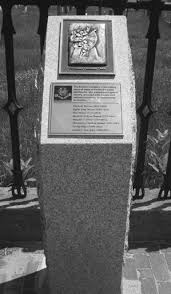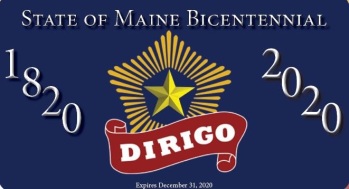“Cultural heritage” doesn’t consist of money or property but of values and traditions. It implies a shared bond, our belonging to a community.
In 2015 I needed a studio that was walkable from the ferry terminal to prepare for the installation of Welcoming the Stranger: building understanding through community based art at the Maine Jewish Museum. https://thestonepath.wordpress.com/2015/10/
The museum is located in the historic India Street corridor. This neighborhood has served as a commercial maritime center for Portland since the 1700s. I walked along the streets that had witnessed the arrival of refugees for centuries. 
Much of what I know about early African American history in Maine, I learned from the stone markers that comprise the Portland Freedom Trail.
Each marker is capped with brass plates commemorating significant events, persons and places in the history of the African American community – after Maine was admitted to the Union – leading up to the Civil War.
https://www.mainehistory.org/PDF/walkingtourmap.pdf
Every day, on my way from the ferry, I read another marker. Little did I realize I was also on the path taken by ‘refugees from slavery’ on the Underground Railroad.
Portland became a northern hub of the Underground Railroad because it was so easy to get to by rail and sea. People who helped African-Americans escape used railroad terminology as a code to describe their activities. People who moved the refugees were called conductors. The buildings that sheltered them were stations and the people who fed and clothed them until they were ready to move on were stationmasters. https://www.newenglandhistoricalsociety.com/6-stops-underground-railroad/
One morning, as I crossed Newbury Street – the site of one of the oldest synagogues in Portland – I noticed construction fencing surrounding the location of the former Abyssinian Church and Meeting House. http://www.abyme.org/
By the early 19th century, Portland (Maine) had a small, vital African American population. Black Mainers were raising families and running small businesses. Many worked in maritime trades as sailors, longshoremen and fishermen. As the country was roiled by the question of slavery, African Americans in Maine became leaders in the anti-slavery movement, founding and leading local organizations.
https://visitmaine.com/things-to-do/arts-culture/portland-freedom-trail
The Portland Abyssinian Meetinghouse is the 3rd oldest African American Meetinghouse in the United States. It was built (1828 – 33) by members of the African American community. The meeting house housed a school for Black children, church suppers, concerts and religious services. Frederick Douglas and William Lloyd Garrison both spoke from the Abyssinian’s pulpit. https://www.youtube.com/watch?v=Si24aCgUiw4
After the passage of the 1850 Fugitive Slave Act providing for the seizure and return of runaway slaves, members of the Abyssinian Meetinghouse organized escape routes for fugitives to England and Canada.
Although the 1866 Great Portland Fire destroyed the surrounding neighborhood, church members protected the meeting house by putting wet blankets on the roof. Thereby, not only saving its history, but preserving a cultural heritage of community, education, and freedom.
The fencing serves to protect what remains and to indicate future restoration – of not only the building – but of the African American community’s place in the history of Portland.
Digging Things Up
In 2020, Maine celebrated its Bicentennial.
In 1820, as a result of the Missouri Compromise, Maine was admitted into the Union as a free state and Missouri as a slave state. Implicit in this event was the assumption that Maine was not involved in the slave trade.
Dr. Kate McMahon www.katemcmahon.net/ writes about the “complicity and connections of economies” that emerged in her research of the history of free African Americans in Maine. By 1820 she maintains Maine shipping vessels were still the predominant ships engaged in the illegal slave trade. The citizens of New England have been blind to the notion that “ their illustrious maritime traditions are deeply rooted in slavery.”
The economic forces that kept the institution of slavery alive were based on the triangular trade. Africans were captured, enslaved and transported through the Middle Passage, the route taken from Africa to the New World – North America, South America and the Caribbean. Slaves worked on plantations to refine sugar into molasses which was shipped to New England and distilled into rum. The rum was sent to Africa and traded for slaves.
…Salted cod was a cheap food source that kept well in the warmer climates of Cuba, South America and the Caribbean. Maine ship owners supplied salted cod to feed the slaves in exchange for barrels of molasses. Ship captains would sell the molasses to one of Portland’s seven rum distilleries.
https://www.mainehistory.org/PDF/walkingtourmap.pdf

In her presentation with Thomas Zeigler at the Maine Historical Society entitled Freedom’s Woods: The African American Community of Peterborough in Warren, Maine , McMahon describes her “archeological” approach to ‘unearthing’ the history of the largest African American settlement in Maine – known as Peterborough.
In her 10 year quest to solve the mystery of Peterborough, she reviewed receipts, tax records, census data, deeds, probate birth/death/marriage certificates, wills, newspaper microfiche, legislation, interviews, ship logs. (I believe I may have found a kindred spirit researcher.)
https://www.youtube.com/watch?v=r7U-ym0kZqs
In 1775 Amos Peters, an African American slave, won his freedom by enlisting and serving in the Continental Army. At the end of the Revolutionary War, he was given 150 acres of land on South Pond near Warren, Maine by General Henry Knox. (The reason behind the ‘gift’ remains a mystery.)
 Sometime around 1782, Sarah (Peters) was brought to Warren as a slave. After slavery was outlawed in Massachusetts, Sarah successfully sued for her freedom and married Amos Peters. The Town of Peterborough was established.
Sometime around 1782, Sarah (Peters) was brought to Warren as a slave. After slavery was outlawed in Massachusetts, Sarah successfully sued for her freedom and married Amos Peters. The Town of Peterborough was established.
By 1823, descendants of Amos and Sarah Peters constructed a school for African American children. It was the first school district in Maine designated for “colored people.” The construction was paid from monies earned from the sale of an ‘excess of alewives.’

The economic decline after the civil war, loss of shipyards, westward expansion, as well as the collapse of alewife fisheries, probably contributed to the disappearance of the town itself.
By 1910 – the school closed due to the lack of students.
All that physically remains of the Town of Peterborough is a sign at the entrance to the cemetery, a cellar hole (possibly belonging to that of the school) and unmarked headstones.

There are no headstones for Amos and Sarah Peters.
The African American Town of Peterborough was established on land that once belonged to the Wabanaki. It was located 11 miles from Waldeboro – the current home of the Mednoka Heritage Seed Program – and only 10 miles from the Passamaquoddy middens.
Within this small triangle of land situated along mid-coast Maine, there are ‘remains’ of cultural heritages. Some we may wish to embrace. Some we may wish to erase.
- Some of exclusion, betrayal, denial, appropriation.
- Some of inclusion, truth, belonging, community.
Culture and its heritage reflect and shape values, beliefs, and aspirations, thereby defining a people’s national identity. ’The ‘Ethics of Cultural Heritage’ is a treatise on the complexities of the concepts underlying cultural heritage. https://plato.stanford.edu/entries/ethics-cultural-heritage/
But in some ways it is simple:
-
-
- Are we willing to listen to each other?
- Are we willing to revise our beliefs?
- Are we willing to re-examine our histories – personal and collective?
- Do we want our cultural heritage to echo the underpinnings of the residents of Peterborough?
-
McMahon writes:
“I think what was most interesting about their (Peters) relationship is that they fostered the sentiment of freedom, of this love of liberty, of this notion of pursuing justice for themselves and for their families and this community.”




Dear Jo, thank you for this delightfully meandering piece which is all drawn beautifully together in the end, like threads in a tapestry. So many interesting topics woven together. Coincidentally I ate my last apple from this fall that was taken (with permission) from a neighbor’s tree. There is still applesauce in the freezer and I had some this morning as part of breakfast. We are part of a wondrous and challenging whole. Thank you for your art in words, objects and spinnings of thought.
This was a really interesting read! Thank you!
Interesting history Jo. Thanks. Lynn
Great job exploring history
Thanks, Jo, for another delightful read. Part facts, part poetry, part visual, part sensual – all woven together into a rich read. You are truly gifted. And, I always learn something new from your blogs – alewife! Yes, I believe you do need to meet Dr. Kate McMahon!
Jo, this is something we all need to wrestle with in this country founded on discrimination, appropriation, and violence. I know the reflection and conversations have started for some people, that it will take time and dedication to LISTENING and moving FORWARD. Amanda Gorman’s piece at the inauguration expressed it beautifully.
For some reason, the sentence about the school closing ‘for lack of students’ has stuck with me and saddens my heart…
Fascinating to read and learn about cultural heritage in the context of the history of Africa Americans in Maine; well written as always. Thank you for sharing your research and insights with us.